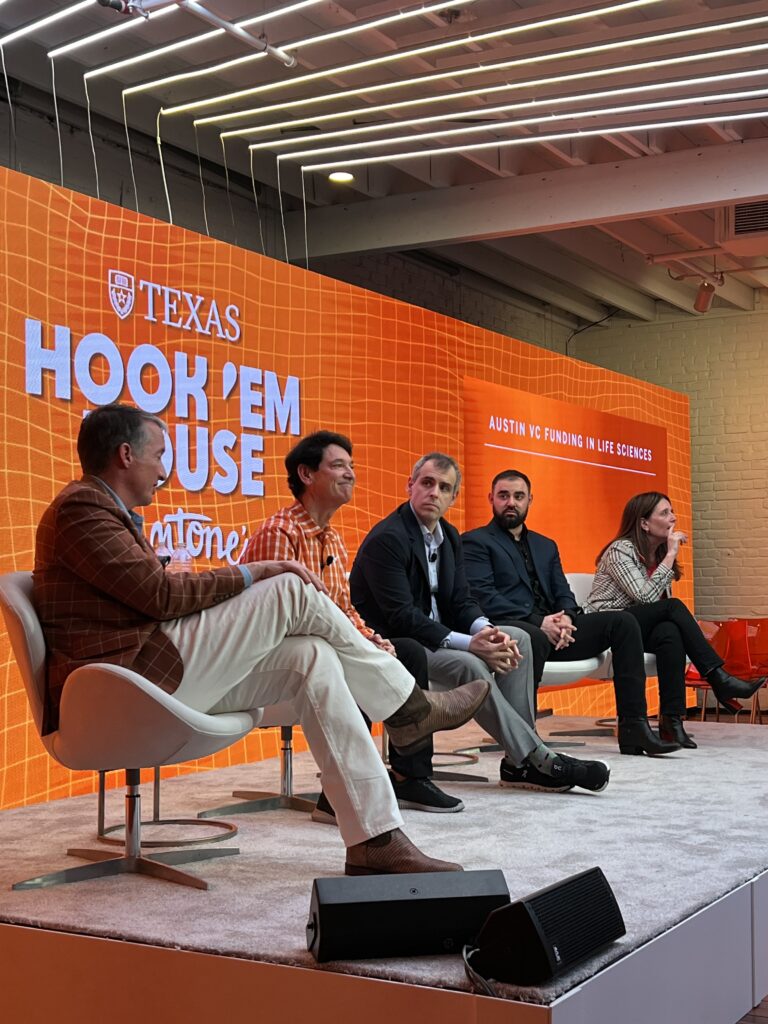
Austin aims to be one of the nation’s top hubs for the life sciences industry, which includes biotechnology, biochemistry, genetics, cellular biology, medical devices, and more.
To that end, a prestigious panel gathered Friday afternoon at SXSW at Antone’s Night Club on Fifth Street, which the University of Texas took over and renamed the Hook’ Em house.
Jay Hartzell, president of the University of Texas at Austin, said the life sciences industry is one of the most significant opportunities for the University of Texas and the Dell Medical School. In April 2023, UT announced plans for the UT Austin Medical Center with the University of Texas MD Anderson Cancer Center and a UT Austin hospital.
Hartzell led the SXSW panel, which included Jim Breyer, founder of Breyer Capital, Andre Esteva, Founder and CEO of ArteraAI, Thomas J. Cahill, Newpath Partners LP, and Claudia Lucchinetti, Dean of the Dell Medical School and senior vice president for medical affairs at UT Austin.
“What we are seeing for the first time is the depth and maturity of AI and computation applied to the life sciences and healthcare,” Breyer said.
In addition, visual computing is becoming increasingly important in healthcare, he said. If healthcare workers harness these technologies, they will save people’s lives and improve lives so people live longer and better, he said.
Lucchinetti said technology’s impact on healthcare is transformative. It’s more than fixing a broken healthcare system; it’s about reimagining healthcare.
“You also think about what people want from healthcare, and they want a much more personalized, tailored experience,” she said. Data is the rocket fuel.”
Lucchinetti said the convergence of AI, computers, data, and machine learning leads to an accelerated discovery rate. The other significant change is that in medical school, students used to have to memorize a lot of information, but now that’s not the case anymore, she said.
“The EQ side of training our future physicians is even more important,” Lucchinetti said. Doctors also need to know data science. The workforce training across the board is changing. The healthcare industry is not prepared for the transition to human and machine care delivery, she said.
“The opportunities are endless,” she said.
Austin can learn a lot from Boston, the country’s number one life sciences hub, with 253 startups and 145 percent growth, Cahill said. The Boston life sciences hub grew partly through government incentives, including $115 million in tax deductions for biotech companies that are still being used today.
Cahill founded Arena BioWorks, a biomedical research institute in Boston. Breyer could open a second office in Austin. It’s like a Bell Labs for biotech, Cahill said.
Today, Breyer said that some of the nation’s top cancer scientists don’t even use computers. But in five years, he said most patients will not go to a specialist who doesn’t rely on deep AI and computational systems.
Breyer said these technologies are essential for drug discovery. They also enable doctors, nurses, and patients to understand more fully what’s wrong and what can be done about their health to live longer and better.
Also, today, few people own their medical data, but five years from now, 90 percent of all people should have the right to their medical data and the medical data of their close relatives, Breyer said.
“You need to see the data, and that just doesn’t exist today,” Breyer said. “Put it in the hands of patients, doctors, and nurses, and great things will happen.”
Good data is essential to healthcare discoveries, Cahill said. Finland is the best place in the world right now for the availability and quality of health data, he said. Cahill encouraged Austin to create its own data bank that would attract researchers and companies. He said he often travels to Helsinki to access its health data vaults.
In the late 1970s, Finland’s leadership started taking blood samples and patient data from everyone. Cahill said that the Finnish databank has led to most discoveries about genetics and disease, especially in the autoimmune space.
“The general public is not seeing it right away – CRISPR solved sickle cell disease – one of the biggest health issues – 6 percent of the population carries that,” Cahill said. “It’s going to be gone in the next ten years because of these drugs. That happened in Boston, and you can do a similar thing here with the leadership.”
Lucchinetti said she’s most excited about the potential to bring engineering and technology to medicine in concrete ways that solve medical diseases like MS, which she sees as an electrical engineering problem.
“Solving the greatest unmet needs of our patients in healthcare will require a transdisciplinary approach,” Lucchinetti said. There’s something special here at the University of Texas at this time in Austin.”
Breyer moved to Austin four years ago. He said what makes the city special is the ability to gather 10 people from UT, VCs, technologists, healthcare experts, and other disciplines around a dinner table to discuss ideas.
“That doesn’t happen in most other places where it’s a mix of skills and tremendous comradery,” Breyer said.
Esteva, founder and CEO of ArteraAI, said the four key ingredients for a health sciences startup hub are venture capital, entrepreneurs, talented engineers, and a top-tier research university, and Austin has all of them.
ArteraAI, based in San Francisco, created tests for prostate cancer. Esteva formed a company in 2021 that raised $110 million and has 100 employees.
Hartzell urged Esteva, a graduate of UT, to move back to Austin and even jokingly offered him two tickets to the UT vs—Georgia Football game.
.
